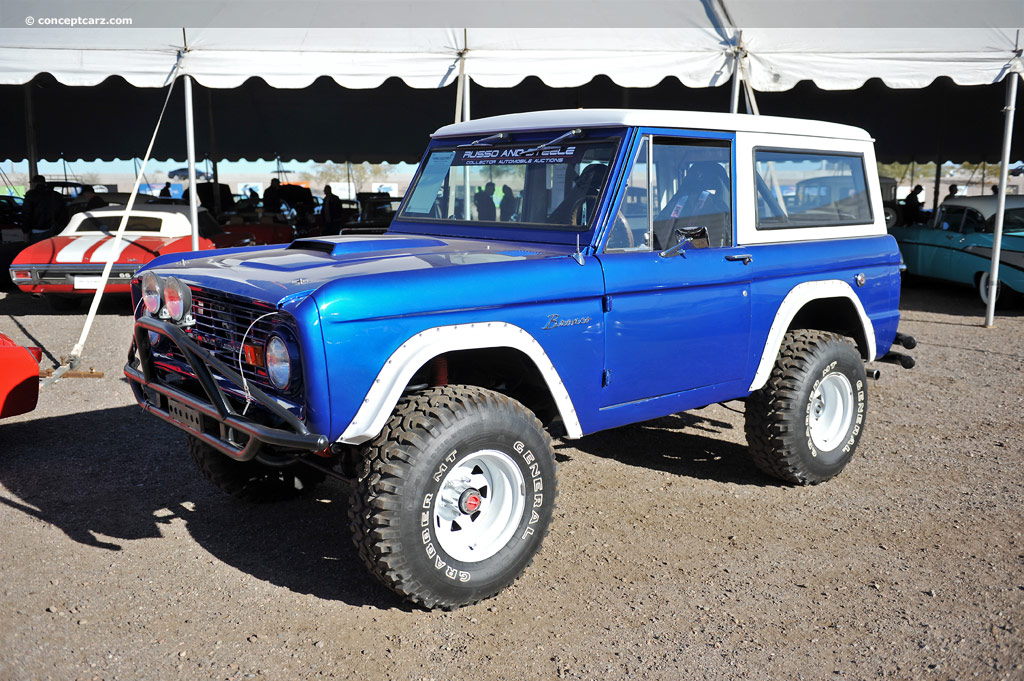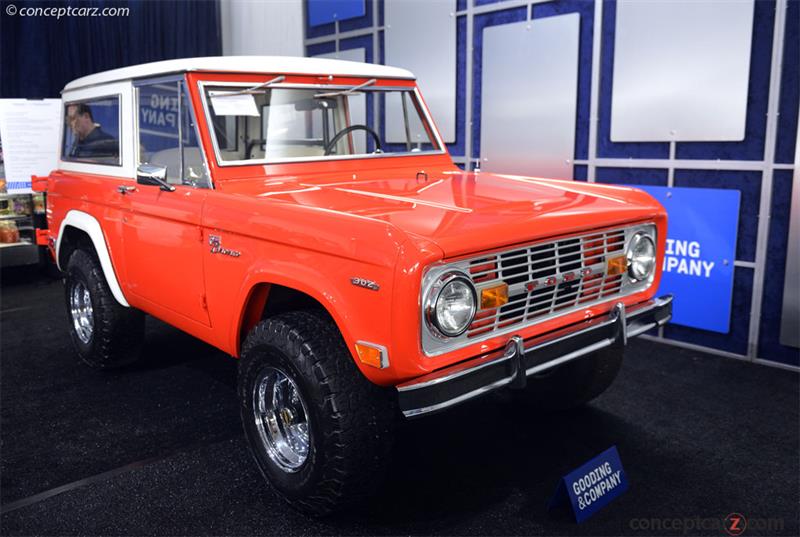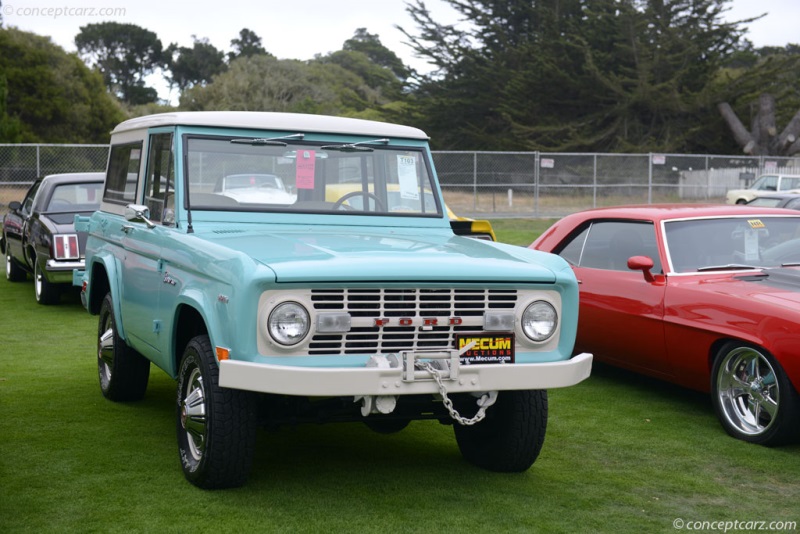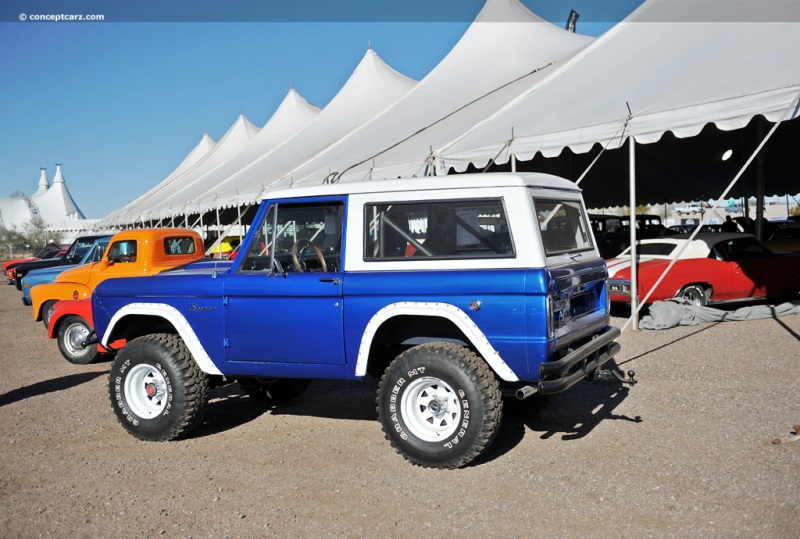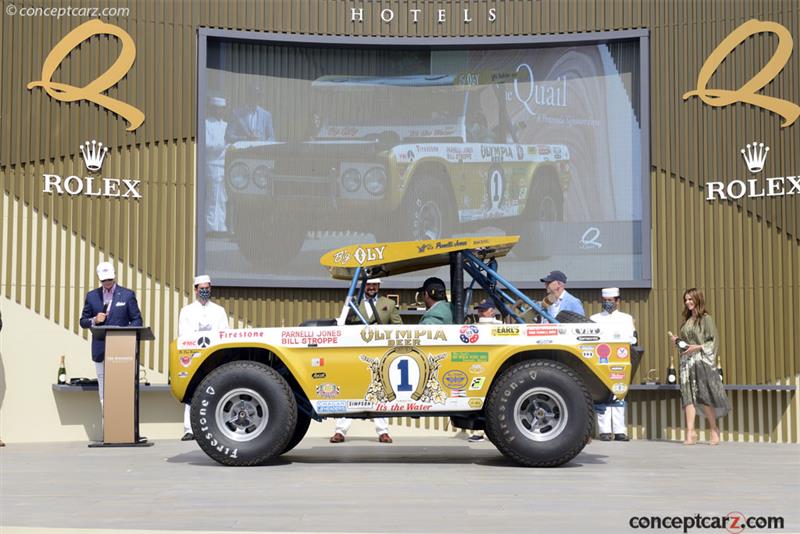1969 Ford Bronco Navigation
History
From 1966 through 1996 Ford produced a stylish and popular SUV named the Bronco. In 1994 a Ford Bronco was seen on TV in a low-speed chase being pursued by the Los Angeles Police Department. Behind the wheel was O.J. Simpson.
The Ford Bronco sat atop a small 92 inch wheelbase which made it suitable for off-road excursions. Its body, frame and suspension were all new and did not share with any other vehicles. The brakes and axles were courtesy of the Ford F-100 trucks. The rear suspension had leaf springs in a Hotchkiss design. Coil springs were used which gave the Bronco an anti-dive geometry which came in handy during snowplowing. The front axle was connected by leading arms and a lateral track bar. A heavy duty suspension was available, but at an additional cost.
The design was simple with flat glass, no-frills bumpers, and a square body. The $2194 base price included front bucket seats, rear bench seat, a CB radio, and tachometer. An auxiliary gas tank, snowplow, winch, tow bar, posthole digger, campers, overdrive units, and an array of tires and wheels were also available.
The idea for the Bronco was conceived by Donald N. Frey, Fords product manager and the same individual who had a big part in the creation of the Ford Mustang. Paul G. Axelrad was responsible for the design while Lee Iacocca played a part in getting the Bronco into production.
When introduced the Bronco was instantly popular and it took a few years for other marques to catch up. By the close of the 1960's Chevrolet had introduced their Blazer and quickly began capturing market share. Ford responded by adapting a larger and more powerful engine to the Bronco. The optional 289 cubic-inch V8 was capable of producing 200 horsepower. If that was not enough a 302 cubic-inch V8 was available that raised the horsepower slightly to 205. Albeit, it was not enough to compete with Chevrolet's 350 cubic-inch V8 which produced over 250 horsepower.
During the early 1970's the Blazer proved to be the more popular than the Bronco. The Blazer was selling two-to-one when compared with the Bronco. Optional power steering and an automatic transmission on the Bronco helped boost sales slightly but it was still difficult competing with the Blazer.
From 1966 through 1977 Ford sold around 230,800 Bronco's. During this time the Bronco remained mostly unchanged due to a limited budget.
In 1972 Ford began working on what they codenamed 'Project Short-Horn' which was a redesign of the Bronco. It would not be until 1978 that they introduced the second generation the Bronco which drew some styling cues from the Blazer and based on the F-100 truck. Part of the delays was due to the fuel-crisis of the 1970's.
In 1980 the Bronco underwent another major redesign which was both cosmetic and mechanical. The front end had an independent suspension and also included the TBB, twin traction beam, setup.
The second generation Bronco was produced from 1980 through 1986 and was outfitted with a variety of six and 8-cylinder engines. A 302, 351, and 400 cubic-inch V8's were available. A 300 cubic-inch straight six was also available during the early 1980's and proved to be highly popular due to its low-end torque and reliability.
In 1987 the Bronco underwent another cosmetic and mechanical upgrade though it was still built atop the F-Series platform. Electronic fuel injection was new and greatly improved the fuel economy and power of the engines. A 300 straight-six engine was offered along with a 302 and 351 cubic-inch V8's.
In 1992 the Bronco was again updated with the most notable changes being cosmetic, mostly inside including the accessories and the dash.
In 1997 Ford introduced the Expedition and fazed out the Bronco. The name reappeared in 2004 as a concept vehicle.
Ford Bronco II
The Ford Bronco II was produced from 1984 through 1990 as an alternative to the full-sized Ford Bronco as well as to compete with other marques such as Jeep and Chevrolet. It carried many of the same mechanical components as the Ford Ranger and due to its short wheelbase and high center of gravity; it was occasionally prone to tipping over. This led to the NTSB and other safety groups to open an investigation on the causes and potential safety hazards of the vehicle.
In 1991 it underwent a major redesign and emerged as the Ford Explorer.
Though the Ford Bronco II was unsafe and unreliable, it did manage to be rather popular, due to its compact size, SUV capabilities, and economical price. From 1984 through 1985 the vehicle was equipped with a six-cylinder 2.8 liter engine. In 1986 a 2.9L EFI V6 engine was introduced and placed under the hood. This vehicle quickly gained a reputation for malfunctioning, especially suffering from premature cylinder head failure and a loss of valve train lubrication. These and other issues were resolved by 1989 but it was too little too late.
In 1989 the Bronco II featured new aesthetics including a new front fascia. A few of the later 1989 models and the 1990 versions were given a Dana 35 front axle which replaced the weaker Dana 28. Even though this is not a true second generation model, these are commonly known as the 'second generation' Bronco II.
By Daniel Vaughan | Jun 2006
The Ford Bronco sat atop a small 92 inch wheelbase which made it suitable for off-road excursions. Its body, frame and suspension were all new and did not share with any other vehicles. The brakes and axles were courtesy of the Ford F-100 trucks. The rear suspension had leaf springs in a Hotchkiss design. Coil springs were used which gave the Bronco an anti-dive geometry which came in handy during snowplowing. The front axle was connected by leading arms and a lateral track bar. A heavy duty suspension was available, but at an additional cost.
The design was simple with flat glass, no-frills bumpers, and a square body. The $2194 base price included front bucket seats, rear bench seat, a CB radio, and tachometer. An auxiliary gas tank, snowplow, winch, tow bar, posthole digger, campers, overdrive units, and an array of tires and wheels were also available.
The idea for the Bronco was conceived by Donald N. Frey, Fords product manager and the same individual who had a big part in the creation of the Ford Mustang. Paul G. Axelrad was responsible for the design while Lee Iacocca played a part in getting the Bronco into production.
When introduced the Bronco was instantly popular and it took a few years for other marques to catch up. By the close of the 1960's Chevrolet had introduced their Blazer and quickly began capturing market share. Ford responded by adapting a larger and more powerful engine to the Bronco. The optional 289 cubic-inch V8 was capable of producing 200 horsepower. If that was not enough a 302 cubic-inch V8 was available that raised the horsepower slightly to 205. Albeit, it was not enough to compete with Chevrolet's 350 cubic-inch V8 which produced over 250 horsepower.
During the early 1970's the Blazer proved to be the more popular than the Bronco. The Blazer was selling two-to-one when compared with the Bronco. Optional power steering and an automatic transmission on the Bronco helped boost sales slightly but it was still difficult competing with the Blazer.
From 1966 through 1977 Ford sold around 230,800 Bronco's. During this time the Bronco remained mostly unchanged due to a limited budget.
In 1972 Ford began working on what they codenamed 'Project Short-Horn' which was a redesign of the Bronco. It would not be until 1978 that they introduced the second generation the Bronco which drew some styling cues from the Blazer and based on the F-100 truck. Part of the delays was due to the fuel-crisis of the 1970's.
In 1980 the Bronco underwent another major redesign which was both cosmetic and mechanical. The front end had an independent suspension and also included the TBB, twin traction beam, setup.
The second generation Bronco was produced from 1980 through 1986 and was outfitted with a variety of six and 8-cylinder engines. A 302, 351, and 400 cubic-inch V8's were available. A 300 cubic-inch straight six was also available during the early 1980's and proved to be highly popular due to its low-end torque and reliability.
In 1987 the Bronco underwent another cosmetic and mechanical upgrade though it was still built atop the F-Series platform. Electronic fuel injection was new and greatly improved the fuel economy and power of the engines. A 300 straight-six engine was offered along with a 302 and 351 cubic-inch V8's.
In 1992 the Bronco was again updated with the most notable changes being cosmetic, mostly inside including the accessories and the dash.
In 1997 Ford introduced the Expedition and fazed out the Bronco. The name reappeared in 2004 as a concept vehicle.
Ford Bronco II
The Ford Bronco II was produced from 1984 through 1990 as an alternative to the full-sized Ford Bronco as well as to compete with other marques such as Jeep and Chevrolet. It carried many of the same mechanical components as the Ford Ranger and due to its short wheelbase and high center of gravity; it was occasionally prone to tipping over. This led to the NTSB and other safety groups to open an investigation on the causes and potential safety hazards of the vehicle.
In 1991 it underwent a major redesign and emerged as the Ford Explorer.
Though the Ford Bronco II was unsafe and unreliable, it did manage to be rather popular, due to its compact size, SUV capabilities, and economical price. From 1984 through 1985 the vehicle was equipped with a six-cylinder 2.8 liter engine. In 1986 a 2.9L EFI V6 engine was introduced and placed under the hood. This vehicle quickly gained a reputation for malfunctioning, especially suffering from premature cylinder head failure and a loss of valve train lubrication. These and other issues were resolved by 1989 but it was too little too late.
In 1989 the Bronco II featured new aesthetics including a new front fascia. A few of the later 1989 models and the 1990 versions were given a Dana 35 front axle which replaced the weaker Dana 28. Even though this is not a true second generation model, these are commonly known as the 'second generation' Bronco II.
By Daniel Vaughan | Jun 2006
A original concept designed under engineer Paul Axelrad, the Ford Bronco was an SUV produced from 1966 through 1996.
Original and distinct, the Bronco had a body, suspension, and a frame that wasn't shared with any other vehicle or modeled off of prototypes.
Produced in Wayne, Michigan at Ford's Truck Plant, the full-sized Bronco and the successor Expedition were met with public approval, but not as popular as its infamous low-speed chase with O.J. Simpson running from the police in 1994 made it.
Originally produced as a small SV, on 92 in wheelbase, this 1974 version was popular for off-roading but impractical for towing.
Ford product manager Donald Frey is credited with the idea behind the Bronco. Frey is also responsible for conception of the Ford Mustang.
Sold for a base price of $2,194, the Bronco came with the Ford 170 in³ I6 engine that came with compensations against tilting. Simplistic styling and economized design made the Bronco a reliable vehicle. The frame was a simple box-section ladder with simple C-section bumpers and all flat glass.
It came with a heavy duty fuel pump, six quart oil pan, solid valve lifters, oil-bath air cleaner and a carburetor with a float bowl.
Additional options included a rear bench seat, a tachometer, CB radio, front bucket seats and much more.
It wasn't until 1969 until Bronco had any real competition in the market. This was brought on by the full-size Chevrolet Blazer that offered more luxury and space. Bronco sales continued until 1977.
A team of Bronco's were assembled by racecar builder Bill Stroppe in 1965 for long-distance off road competitions. Rocking the race world in the Mint 400, Baja 500 and Mexican 1000, Broncos joined in with Holman and Moody, Ford's frequently favored race team.
A new, upgraded model, the 'Baja Bronco' was introduced in 1971. The Baja featured quick-ratio power steering, fender flairs, automatic transmission, and much more. Only 650 were sold until 1975, at $5566 compared to the standard V8 Bronco price of $3665.
The mid-1970's fuel crisis put a halt on the re-design of a Bronco based on the F-100 truck, codenamed Project Short-Horn. The oil crisis inspired the Bronco II as the emphasis on the fuel economy became highlighted.
The next major redesign of Bronco happened in 1980, based on the Ford F-series. These lasted until 1986 and came with a new powertrain, suspension and the TTB (twin traction beam) setup in the front end for an independent front suspension.
Before it was replaced by the Ford Explorer, the Bronco II, a more compact version, was a direct result of the second oil crisis of the 1970's. Close to the size of the compact Ranger, the newest Bronco arrived in 1984 and continued until 1990.
The newest feature to arrive with the 1987 models was the electronic fuel injection which improved power and fuel economy.
In 1992, more updates of the Bronco included interior enhancements in the dash and other accessories, mostly cosmetic.
The Bronco was eventually modified to a 4-door version with a new club cab, a short bed, a Bronco tailgate and a fiberglass top. This conversion was done in White Pigeon, Michigan during the late 1980's.
Ford Broncos' continued to be remodeled, updated and produced until 1996.By Jessica Donaldson
Original and distinct, the Bronco had a body, suspension, and a frame that wasn't shared with any other vehicle or modeled off of prototypes.
Produced in Wayne, Michigan at Ford's Truck Plant, the full-sized Bronco and the successor Expedition were met with public approval, but not as popular as its infamous low-speed chase with O.J. Simpson running from the police in 1994 made it.
Originally produced as a small SV, on 92 in wheelbase, this 1974 version was popular for off-roading but impractical for towing.
Ford product manager Donald Frey is credited with the idea behind the Bronco. Frey is also responsible for conception of the Ford Mustang.
Sold for a base price of $2,194, the Bronco came with the Ford 170 in³ I6 engine that came with compensations against tilting. Simplistic styling and economized design made the Bronco a reliable vehicle. The frame was a simple box-section ladder with simple C-section bumpers and all flat glass.
It came with a heavy duty fuel pump, six quart oil pan, solid valve lifters, oil-bath air cleaner and a carburetor with a float bowl.
Additional options included a rear bench seat, a tachometer, CB radio, front bucket seats and much more.
It wasn't until 1969 until Bronco had any real competition in the market. This was brought on by the full-size Chevrolet Blazer that offered more luxury and space. Bronco sales continued until 1977.
A team of Bronco's were assembled by racecar builder Bill Stroppe in 1965 for long-distance off road competitions. Rocking the race world in the Mint 400, Baja 500 and Mexican 1000, Broncos joined in with Holman and Moody, Ford's frequently favored race team.
A new, upgraded model, the 'Baja Bronco' was introduced in 1971. The Baja featured quick-ratio power steering, fender flairs, automatic transmission, and much more. Only 650 were sold until 1975, at $5566 compared to the standard V8 Bronco price of $3665.
The mid-1970's fuel crisis put a halt on the re-design of a Bronco based on the F-100 truck, codenamed Project Short-Horn. The oil crisis inspired the Bronco II as the emphasis on the fuel economy became highlighted.
The next major redesign of Bronco happened in 1980, based on the Ford F-series. These lasted until 1986 and came with a new powertrain, suspension and the TTB (twin traction beam) setup in the front end for an independent front suspension.
Before it was replaced by the Ford Explorer, the Bronco II, a more compact version, was a direct result of the second oil crisis of the 1970's. Close to the size of the compact Ranger, the newest Bronco arrived in 1984 and continued until 1990.
The newest feature to arrive with the 1987 models was the electronic fuel injection which improved power and fuel economy.
In 1992, more updates of the Bronco included interior enhancements in the dash and other accessories, mostly cosmetic.
The Bronco was eventually modified to a 4-door version with a new club cab, a short bed, a Bronco tailgate and a fiberglass top. This conversion was done in White Pigeon, Michigan during the late 1980's.
Ford Broncos' continued to be remodeled, updated and produced until 1996.By Jessica Donaldson
- 1969 Ford Bronco Menu
- Article
- Image gallery
- Valuation
- Specifications
- Profiles
Baja / Dakar Rally / Off-Road Racing Vehicles
Ford
Similar Automakers
Similarly Priced Vehicles
- Volkswagen Beetle 1500 ($1,800-$2,200)
- NSU 1200 TT ($2,200-$2,200)
Average Auction Sale: $74,634
1969 Ford Bronco Vehicle Profiles
Recent Vehicle Additions
Related Automotive News

Meyers Manx Brings 'BIG OLY' To The Yokohama NORRA Mexican 1000 Presented By Method Race Wheels!
AGUA DULCE, CALIF. – Meyers Manx brings Big Oly, the worlds most famous Bronco, to the Yokohama NORRA Mexican 1000.
The Big Oly Bronco is one of the most iconic race vehicles ever built. Driven by the legendary racer Parnelli Jones, it brought...

Barrett-Jackson to Offer a Spectacular Selection of Shelby Vehicles at the 2022 Scottsdale Auction, including a 1967 Shelby Cobra 427, the Lance Reventlow Cobra and a Premier Award-Winning 1965 GT350
Barrett-Jackson will celebrate 50 years of The Worlds Greatest Collector Car Auctions at its 2022 Scottsdale Auction, January 22-30, at WestWorld of Scottsdale. One of the most spectacular No Reserve dockets ever amassed at Barrett-Jackson, including...
WALKER 'THE LEGEND' EVANS NAMED GRAND MARSHALL FOR 6TH ANNUAL NORRA MEXICAN 1000
(Agua Dulce, Calif.) In celebration of his contributions to the sport of Baja off-road racing and his continuing support of the Happiest Race on Earth, NORRA today announced that Walker Evans will be honored as Grand Marshall for the 2015...

ROD HALL NAMED GRAND MARSHAL OF 2014 GENERAL TIRE NORRA MEXICAN 1000
-- Hall of Fame Racer To Be Part of The Happiest Race On Earth --
(Agua Dolce, Calif.) In celebration of his lifelong love affair with off-road motorsports, the Baja peninsula and an entire industry he helped to foster, racing legend Rod Hall...

Norra Names Mark Mcmillin Grand Marshal For 2013 General Tire Mexican 1000
Legendary Baja racing champion and San Diego-based homebuilder Mark McMillin has been named by the National Off Road Racing Association (NORRA) as the honorary Grand Marshal for this years upcoming General Tire NORRA Mexican 1000. The unique fourth...

Baja 1000 Winner Joe Bacal to Start 2013 Off-Road Racing Season at Mint 400
Coming off a solo-driven victory in the 2012 Baja 1000, Joe Bacal and his JTGrey Racing team are ready to race the Lexus LX 570 with full Lexus backing again in 2013, kicking off the season with the Mint 400 this Saturday, March 23 in Las Vegas.
...
